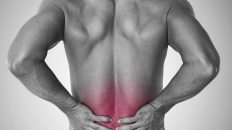What is kinesitherapy
One of the fields of physiotherapy is kinesitherapy (gr. kinesis – movement), otherwise known as movement therapy, or in simplest terms, it is the treatment of movement. It combines all forms of exercises: passive, active, respiratory, isometric, exercises with or without instruments. Kinesitherapy also includes manual therapy. These are rehabilitation methods in which the therapist uses special grips and techniques to release tensions that have developed in the patient’s body. Kinesitherapy affects the patient’s entire body and all organs of movement.
When to use kinesitherapy
The main task of kinesitherapy is to restore the maximum motor and functional capacity of the person from before the injury or illness and to prevent the aggravati
on of motor dysfunctions resulting from various conditions.
Kinesitherapy can be used in the treatment of many conditions, including: neurological diseases, musculoskeletal pain, cardiovascular diseases, as well as in rehabilitation after injury and surgery. Kinesitherapy treatments are widely used in spinal pain syndromes and as prevention of osteoporosis. Kinesitherapy of the spine has a local effect, but at the same time affects the whole body. Therapeutic gymnastics is also used when we want to improve the efficiency of the body. Exercises should be adapted individually to the needs of the individual patient and should be performed under the supervision of a physiotherapist.
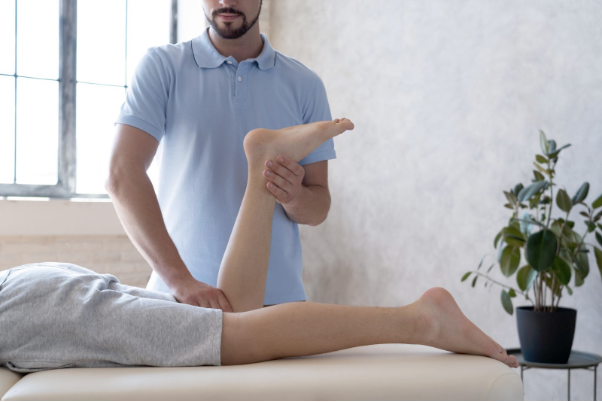
Kinesitherapy objectives
Well-chosen kinesitherapy can bring many benefits to our health and musculoskeletal system. The main effects of kinesitherapy include:
Improved motor function – kinesitherapy helps to restore normal motor function by strengthening muscles, increasing joint range of motion and improving coordination.
Reduction of pain – through kinesitherapy, pain associated with various diseases and injuries can be reduced. Physical exercises such as stretching, strengthening and massage can help reduce muscle tension and pain.
Improving balance and coordination – kinesitherapy can help improve balance and coordination especially in older people or those with neurological conditions.
Strengthening the cardiovascular system – aerobic exercise performed as part of kinesitherapy can improve cardiovascular fitness, which is particularly important for people with cardiovascular disease.
Improve wellbeing and quality of life – regular exercise can have a positive impact on wellbeing and quality of life by reducing symptoms of disease and improving the ability to perform daily activities.
Accelerate the rehabilitation process – kinesitherapy is an important part of rehabilitation after injury and surgery as it helps to restore normal motor function and reduce pain.
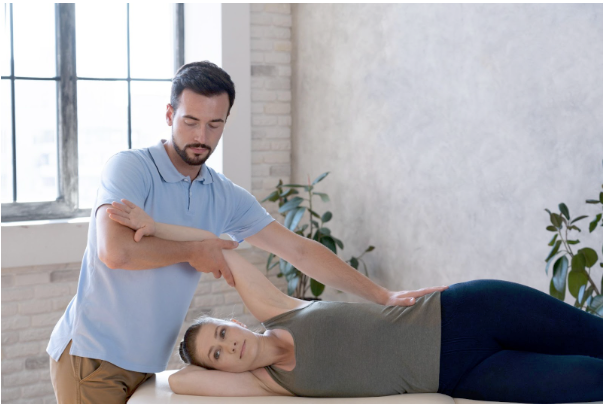
Kinesitherapy with general and local effects
We can divide kinesitherapy according to the area of action – there is a general action and a local action.
General activities can include such forms as:
* general conditioning and general development exercises
* water exercises
* gymnastics
* relaxation exercises
Kinesitherapy with local effects includes, among others
* passive exercises
* active free exercises, active with resistance
* self-assisted exercises
* isometric exercises
* synergistic exercises
* breathing exercises
What is physical therapy?
Physical therapy is a branch of physiotherapy that uses various physical stimuli for therapeutic purposes, such as light, electric current or cold or high temperatures. These stimuli can be of natural origin (such as sunlight) or from specialised equipment, such as in the case of current treatments.
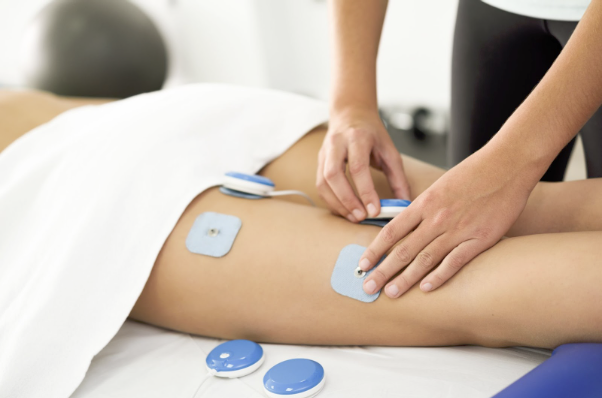
Division of physical therapy procedures
We can divide physical therapy treatments into categories, based on the therapeutic stimuli used.
Electrotherapy – is a branch of physical therapy that uses low and medium frequency electric currents. It is mainly used to reduce pain and stimulate muscle tone, e.g. in muscle atrophy in flaccid paralysis, degenerative diseases and supportive treatment of bone fractures (especially those that are difficult to heal).
Thermotherapy – treatment with warm or cold temperatures is used here. It is a therapeutic method that has been used for centuries and is still very popular because it is simple and effective, and can also be successfully applied at home. As a general rule, it is accepted that cold treatment is mostly used for acute and sub-acute conditions, fresh injuries or trauma, while heat treatment is usually used for chronic conditions with permanent muscle tension. Heat therapies are also very often recommended prior to massage, manual therapy or exercise.
Light therapy – is a branch of physical therapy that uses infrared (IR), visible and ultraviolet (UV) light for therapeutic purposes. Infrared light is most commonly used, as well as thermotherapy, in subacute and chronic conditions of joints and periarticular tissues, in pain syndromes and neuralgia. It is also recommended to use IR light before a massage in order to warm up and prepare the tissues.
UV light has a slightly different application. Among other things, UV rays cause an increase in the production of white blood cells and can therefore be used for hard-to-heal wounds, ulcers or bedsores. They are also often recommended for people suffering from psoriasis or acne vulgaris.
Laser therapy – uses professional medical devices that emit a focused beam of light. This type of therapy is most commonly used for hard-to-heal wounds and ulcers, chronic inflammation, osteoarthritis. Laser treatments are also very commonly used in ophthalmology or aesthetic medicine.
Balneotherapy – is a branch of physical therapy and is based on natural therapeutic factors found in nature. It utilises the beneficial effects of mineral water, mud and other natural mineral substances such as salts, gases or mud to alleviate various types of health ailments.
Balneotherapy is used to treat orthopaedic conditions such as back pain, joint pain or muscle pain, as well as rheumatic diseases such as arthritis or arthritis. Additionally, balneotherapy can help alleviate the symptoms of skin conditions such as psoriasis or eczema, as well as reducing stress and improving mood.
Magnetic field – magnetic field treatment, also known as magnetic therapy, involves the application of magnetic fields of the appropriate frequency and intensity to treat a variety of conditions.
Indications for magnetic field treatment include: degenerative diseases of the spine, difficult bone adhesions, swelling caused by inflammation of the musculoskeletal system, muscle regeneration after sports injuries.
There are contraindications to the use of this treatment, and these include electronic implants such as pacemakers.
Ultrasound (ultrasound, UD) – the use of ultrasound in rehabilitation, is one of the popular treatments used by physiotherapists. Ultrasound is high-frequency sound waves that are transmitted through an ultrasound transducer onto the patient’s skin. In the body’s tissues, ultrasound waves cause vibrations, which can have a beneficial effect on regenerative and healing processes. The use of ultrasound in rehabilitation aims to accelerate tissue healing, reduce pain, reduce inflammation, improve soft tissue elasticity and increase range of motion. Ultrasound can be used to treat a variety of injuries such as sprains, dislocations, joint pains, as well as osteoarthritis.
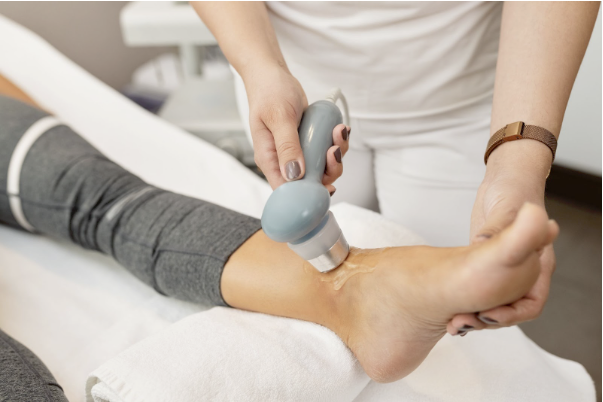
Vibrotherapy – is a safe and non-invasive form of therapy that makes use of the stimulus vibration, or vibration. These vibrations are transmitted to the patient’s body via vibration therapy platforms, vibration mats or vibration therapy chairs. When it comes to choosing the right equipment, we recommend special prudence, as not all equipment that generates vibration will be therapeutic devices. As with all other treatments – only the selection of appropriate parameters (in this case, frequency, amplitude and duration of the treatment) can guarantee positive therapeutic effects.
At this point, it is worth mentioning the Polish company Vitberg, which is a leading manufacturer of vibrotherapy devices and these products are certified therapeutic products.

Combination therapies
Effective physiotherapy involves the use of appropriate therapeutic techniques and exercises to help improve motor function and reduce pain in patients.
The selection of appropriate physiotherapy should be based on an individual approach to each patient and their needs. The physiotherapist should carry out a detailed assessment of the patient’s condition, including an analysis of the patient’s medical history, symptoms, activity level and therapeutic goals. Based on this information, the physiotherapist can plan appropriate therapy.
In order for physiotherapy to have the desired effect, it is important to use a variety of therapeutic techniques, such as massage, therapeutic exercises, electrostimulation, cryotherapy, laser therapy or manual therapy. The physiotherapist should use the appropriate techniques to tailor the therapy to the individual patient’s needs and achieve the best results.
It is also important that the patient is involved in the physiotherapy process and performs the prescribed exercises and therapy at home. Collaboration between the physiotherapist and the patient is key to achieving the best therapeutic results.
Combining kinesis and physical therapy
Comprehensive physiotherapy that will be maximally effective (in a given case) should combine both physical treatments and appropriately selected physical exercises.
Below are some tips for combining kinesis and physical therapy:
Use of thermotherapy: Thermotherapy is a physical therapy technique that involves applying heat or cold to the healing area to reduce pain, improve blood circulation and reduce inflammation. It can be applied before kinesiotherapy exercises to improve their effectiveness.
Use of muscle electrostimulation: Muscle electrostimulation is a physical therapy technique that involves the use of electrical current to stimulate muscles to contract. It can be used as an additional tool with kinesiotherapy exercises to strengthen muscles and improve their function.
Integration of isometric and dynamic exercises: Isometric exercises involve maintaining muscle tension without movement, while dynamic exercises involve muscle movement. Combining these two types of exercise can help to increase muscle strength and improve joint mobility.
Bibliography:
1.https://www.mp.pl/pacjent/rehabilitacja/fizjoterapia/kinezyterapia/129365,kinezyterapia
2. https://bitmed.pl/blog/35-na-czym-polega-kinezyterapia-
3. https://fizjoterapeuty.pl/fizykoterapia/elektrostymulacja.html
4. Mika T., Kasprzak W., Fizykoterapia, Wydawnictwo Lekarskie PZWL, Warszawa 2013.
5.https://www.mp.pl/pacjent/rehabilitacja/fizjoterapia/fizykoterapia/130232,fizykoterapia
6. https://www.wibroterapia.com/wibroterapia-dla-laika-po-co-kiedy-i-dla-kogo/


